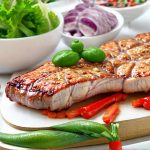Maintaining adequate hydration is fundamental to overall health and wellbeing, yet many people struggle to drink enough water throughout the day. Often, we focus solely on drinking water as the solution, overlooking a powerful ally in our quest for hydration: food! A significant portion of our daily fluid intake can actually come from what we eat, and strategically pairing foods can not only boost your hydration levels but also enhance nutrient absorption and overall dietary balance. This isn’t just about choosing watery fruits and vegetables – it’s about understanding how different nutrients interact with water in the body and leveraging those interactions to maximize hydration efficiency. It’s a holistic approach that moves beyond simply “drinking eight glasses of water” and embraces a more nuanced, food-first philosophy.
The concept of smart food pairings for hydration acknowledges that our bodies don’t just absorb water passively. Certain nutrients facilitate water absorption, while others can actually hinder it. For example, electrolytes like sodium, potassium, and magnesium are crucial for regulating fluid balance within cells. Combining hydrating foods with those rich in these essential minerals optimizes how your body uses the fluids you consume. Furthermore, the texture and fiber content of food play a role – fibrous foods hold water well and slow down digestion, leading to sustained hydration. This article will explore specific pairings that can help you achieve balanced daily hydration, moving beyond simple thirst quenching towards a more sustainable and effective approach to fluid intake.
The Power of Electrolyte-Rich Pairings
Electrolytes are essentially minerals carrying an electric charge when dissolved in fluids like blood. They’re vital for numerous bodily functions, including nerve impulse transmission, muscle contraction, and – critically – maintaining fluid balance. When we sweat, or even simply go about our daily activities, we lose electrolytes. Replacing these lost electrolytes is key to staying hydrated, as they help regulate how water moves into and out of our cells. Pairing hydrating foods with natural sources of electrolytes isn’t just beneficial; it’s essential for optimal hydration.
Consider the classic pairing of watermelon and a sprinkle of sea salt. Watermelon boasts over 90% water content, providing immediate hydration. The addition of a tiny amount of sea salt provides sodium, which helps the body retain that fluid more effectively. This isn’t about adding excessive salt; it’s about restoring a small amount lost through natural processes. Similarly, pairing cucumber slices with a pinch of Himalayan pink salt achieves a similar effect – enhancing water absorption and preventing rapid fluid loss. Beyond sodium, potassium and magnesium are also crucial electrolytes found in various foods.
Another excellent combination is strawberries paired with a small handful of almonds. Strawberries are rich in both water and potassium, while almonds provide magnesium. Magnesium plays a role in electrolyte balance and can help prevent muscle cramps that often accompany dehydration. These pairings demonstrate how thoughtful food combinations can significantly improve hydration efficiency compared to simply drinking plain water alone. This isn’t about replacing water; it’s about amplifying its benefits. If you are looking for more ways to support kidney health, explore helpful food pairings that can contribute to overall well-being.
Hydrating Breakfast Boosters
Breakfast is an excellent time to kickstart your hydration for the day. Many traditional breakfast choices, unfortunately, are relatively low in fluid content and may even be dehydrating (think dry toast or sugary cereals). Instead, focus on incorporating hydrating foods into your morning routine. A fantastic option is oatmeal made with water or unsweetened almond milk, topped with berries and a sprinkle of chia seeds. Berries provide both hydration and antioxidants, while chia seeds are known for their ability to absorb water, creating a gel-like consistency that slows digestion and promotes sustained hydration.
Another effective breakfast pairing involves Greek yogurt (which has a high water content) combined with sliced peaches and a small amount of unsalted nuts. Peaches offer natural sugars for energy alongside valuable electrolytes, while the nuts provide healthy fats to keep you feeling full and satisfied. It’s important to avoid overly processed breakfast foods laden with sugar, as these can actually draw water from your body during digestion. Prioritize whole, unprocessed foods that naturally contain hydration-promoting properties. To further refine your morning routine, consider reviewing morning hydration techniques for optimal bladder health.
Finally, consider a smoothie made with spinach, banana, and coconut water. Spinach is incredibly hydrating, bananas offer potassium, and coconut water is a natural source of electrolytes – making this a powerful hydration booster to start your day right. Remember to adjust the ingredients based on your preferences and dietary needs, but the core principle remains: prioritize hydrating foods alongside electrolyte-rich options for a balanced breakfast.
Lunchtime Hydration Strategies
Lunch often presents a challenge for maintaining hydration, as many people opt for quick, convenient meals that aren’t necessarily fluid-rich. Sandwiches, while convenient, can be surprisingly dehydrating if not paired thoughtfully. Instead of opting for dry bread and processed fillings, choose whole-grain bread with hydrating fillings like sliced turkey or chicken breast, avocado, lettuce, and tomato. Avocado is particularly beneficial, providing healthy fats that aid in nutrient absorption and a creamy texture that contributes to satiety.
Salads are inherently hydrating, but can be enhanced further through strategic pairings. A salad featuring mixed greens, cucumber, bell peppers, and grilled salmon offers both hydration and essential nutrients. Salmon provides omega-3 fatty acids, which support overall health, while the vegetables contribute valuable electrolytes. Dress your salad with a light vinaigrette made with olive oil and lemon juice – avoiding creamy dressings that can be heavier and less hydrating. Focus on colorful vegetables for maximum nutrient density and hydration. You may also want to explore smart food combinations designed to promote better bladder comfort alongside your midday meal.
A soup-based lunch is another excellent option. Broth-based soups are incredibly hydrating, and adding vegetables like carrots, celery, and spinach further enhances their nutritional value. Avoid cream-based soups, which can be more difficult to digest and less efficient at providing hydration. Pairing a vegetable or lentil soup with a side of whole-grain crackers provides a balanced and satisfying lunch that supports optimal hydration throughout the afternoon.
Evening Rehydration Rituals
Often overlooked, evening is an important time to focus on rehydrating after a day’s activities. Many people experience mild dehydration by the end of the day without realizing it. A simple yet effective approach is to incorporate hydrating snacks into your evening routine. Celery sticks with hummus provide both hydration and plant-based protein, while grapes offer natural sugars for energy alongside valuable antioxidants.
A light dinner featuring grilled fish or chicken with steamed vegetables and quinoa is a fantastic option. Fish provides omega-3 fatty acids, vegetables contribute essential electrolytes, and quinoa offers complex carbohydrates for sustained energy. Avoid heavy, processed meals that can disrupt sleep patterns and hinder digestion. Prioritize easily digestible foods that won’t strain your system before bedtime. To help plan your evening meal, consider looking at a sample 3-meal plan focused on urological support.
Finally, consider sipping on herbal tea – chamomile or peppermint are excellent choices – as a calming and hydrating way to end the day. Herbal teas are naturally caffeine-free and offer additional health benefits beyond hydration. Avoid sugary drinks or alcohol before bed, as these can disrupt sleep and further dehydrate you overnight. Remember that consistent hydration throughout the day is key, but incorporating specific evening rituals can help ensure you wake up feeling refreshed and well-hydrated.
For those seeking a more comprehensive approach to dietary planning, reviewing low-sodium diet menus can provide additional insights into supporting overall health and hydration levels.
To refine your grocery shopping habits for optimal hydration, explore smart grocery choices that prioritize bladder wellness and fluid intake.
Finally, if you’re interested in learning more about the impact of food on urinary health, investigate daily food patterns that can minimize nighttime disruptions and promote restful sleep.





















